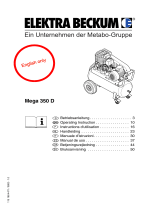
ENGLISHen
10
4.3 Risks associated with recurring move-
ments
- When working with the air tool, you may experi-
ence an uncomfortable sensation in your hands,
arms, shoulders, neck or other body parts.
- Make sure you are in a comfortable position to
carry out work with the air tool, check that the tool
is held securely, and avoid any awkward positions
that make it difficult, for example, to keep your
balance. If carrying out work over an extended
period, you/the operator should change position
occasionally. This should help to avoid fatigue and
any unpleasant sensation.
- If the operator experiences persistent symptoms
such as feeling unwell, aches, pains or throbbing,
a prickling or burning sensation, loss of hearing, or
joint stiffening, these warning signs must not be
ignored. The operator should advise the employer
of these symptoms and consult a qualified doctor.
4.4 Risks associated with accessory parts,
consumable materials
- Disconnect the air tool from the air supply before
securing or replacing the accessory part.
- Only use accessories or consumable materials
that are designed for this tool and that fulfil the
requirements and the specifications listed in these
operating instructions.
4.5 Risks in the workplace
- Slipping, tripping and falling are the main reasons
for accidents in the workplace. Pay attention to
surfaces that may have become slippery as a
result of using the air tool, and also be careful that
the air hose does not cause someone to trip.
- Proceed carefully when working in unfamiliar envi-
ronments. Power cables and other supply lines
may represent a hidden risk.
- The air tool is not designed for use in explosive
environments and is not insulated against contact
with sources of electric power.
4.6 Risks associated with dust and vapours
- The dust and vapours generated when the air tool
is used may carry health risks (e.g. cancer, birth
defects, asthma and/or dermatitis); it is therefore
imperative that a risk assessment is carried out in
relation to these risks and that suitable controls
are then implemented.
- The risk assessment should take into account
both the dust generated while the air tool is used
and any existing dust that may be raised during
operation.
- The air tool must be operated in accordance with
the recommendations set forth in these instruc-
tions and must be maintained in order to minimise
the release of dust and vapours.
- The extracted air must be discharged in such a
way that, in a dust-filled environment, the
minimum of dust is raised.
- If dust or vapours are generated, the main priority
is to control these at the point where they are
released.
- To avoid increasing the amount of dust or vapours
generated unnecessarily, the consumables must
be selected, maintained and replaced in accord-
ance with these instructions.
- Use protective breathing apparatus in accordance
with your employer instructions or in accordance
with health and safety regulations.
- Working with certain materials causes emissions
of dust and vapours that can give rise to potentially
explosive conditions.
4.7 Additional safety instructions
- Compressed air can cause serious injury.
- When the air tool is not in use, and before
replacing accessory parts or when carrying out
repairs, you must ensure that air supply is shut off,
that the air hose is depressurised and that the air
tool is disconnected from the compressed air
supply.
- Never direct the air jet at yourself or other people.
- Whiplashing hoses can cause serious injury.
Therefore always check that the hoses and their
fixtures are in good condition and that they have
not become loose.
- Connect the air tool with quick-action coupling to
the compressed air supply.
- If universal swivel couplings (claw couplings) are
being used, locking pins are also required. You
should also use whip check hose restraints in
case there is a problem with the connection
between the hose and air tool or between the
hoses themselves.
- Ensure that the maximum pressure specified on
the air tool is not exceeded.
- Never carry air tools by the hose.
4.8 Additional safety instructions
- If applicable, observe any special health and
safety or accident prevention regulations
governing the use of compressors and
compressed air tools.
- Ensure that the maximum supply pressure speci-
fied in the Technical Specifications is not
exceeded.
- Do not operate the tool unless you are completely
focused. You must be alert, pay attention to what
you are doing and proceed cautiously when
working with an air tool. Never use a tool when you
are tired or under the influence of drugs, alcohol or
medication. Just one moment's carelessness
when using the tool can cause serious injury.
- Make sure your workplace is clean and well lit.
Untidy or poorly lit workplaces can cause acci-
dents.
- Keep air tools away from children.
- Do not store the tool outdoors or in damp condi-
tions without protection.
- Protect the air tool, especially the compressed air
connection and the control elements from dust
and dirt.
- Take suitable precautionary measures to protect
yourself and your environment against accidents.
- The air tool is not suitable for treating food
supplies and medication.
- Do not smoke, ignite sparks or light a fire.
- It is essential to ensure that the working area is
well ventilated.
- Always wear protective clothing, in particular,
breathing protection with active carbon filter.







